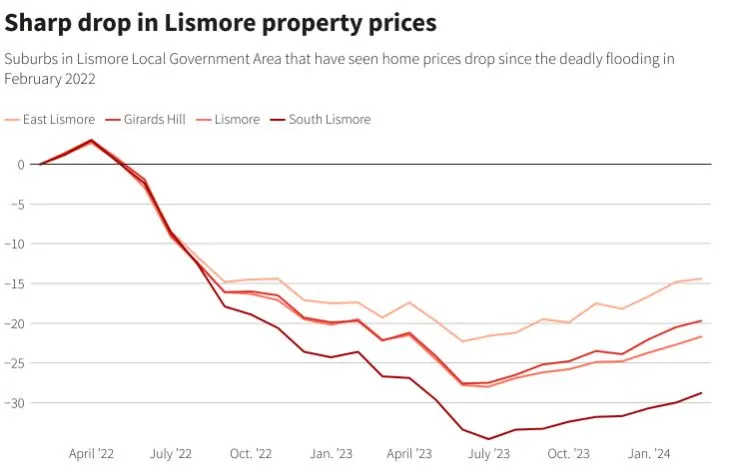The Australian and New Zealand property markets are increasingly grappling with the pressing issue of climate risk in real estate. As climate change continues to intensify, these markets face significant challenges that impact property values, insurance premiums, and overall market stability. This article delves into the intricate relationship between climate risk and the property markets in these regions, exploring the consequences and future implications.
The Growing Threat of Climate Risk in Real Estate
Climate risk in real estate is becoming a critical concern for property owners and investors in Australia and New Zealand. The rising frequency and severity of natural disasters, such as floods, bushfires, and storms, are leading to substantial economic losses and driving up insurance premiums for flood-prone areas. For instance, the eastern Australian town of Lismore experienced devastating floods that severely impacted property values and insurance costs.
In New Zealand, around 20% of houses are located on floodplains, exposing a significant portion of the housing market to climate-related risks. The impact of these disasters on property value is profound, with each increase in bushfire risk rating leading to a 2% decrease in a home’s value. Similarly, a 1% rise in the chance of a 50-centimeter flood results in a 0.8% drop in property value.

Source-Reuters
Insurance Premiums and Property Value Impact
Insurance premiums for flood-prone areas are reaching unaffordable levels for many homeowners. In Australia, Allianz revealed that 74% of customers with the highest flood rating did not purchase flood cover last year, up from 63% previously. This trend is even more pronounced in high-risk areas like Lismore, where 90% of residents lack flood insurance. By 2030, it is expected that 4% of Australian properties will be uninsurable due to climate risk.
In New Zealand, the situation is similarly dire. Following major floods in 2023, around 1,000 properties became uninsurable and were purchased by authorities. Insurance premiums have doubled over the past decade, driven by growing climate risk and high construction costs. Kerry Watt, Director of Financial Stability Assessment and Strategy at the Reserve Bank of New Zealand, emphasizes the need for property buyers to be aware of the specific risks to the properties they are considering.
Australian and New Zealand property markets vulnerability to Climate Change
The Australian and New Zealand property markets are highly vulnerable to climate change. Natural disasters could wipe out about A$800 billion from Australia’s housing market by 2030, representing approximately 6.7% of the total value. This vulnerability is exacerbated by the high concentration of wealth in real estate in these countries. Among OECD nations, Australians have the second-highest amount of wealth in real estate, while New Zealand also ranks above average.
Despite these risks, the housing markets in flood-prone or coastal areas have shown resilience, with home prices often reclaiming previous peaks. However, this resilience may mask underlying vulnerabilities that could surface with future climate events. In Lismore, for example, land prices halved, and many residents left town due to the rising cost of flood insurance.
The Economic and Community Impact
Climate change poses a significant threat to the economy and communities in Australia and New Zealand. When natural disasters strike, they affect not only individual properties but also businesses and the wider economy. The impact on property value from natural disasters can lead to economic instability and reduced consumer confidence in the property market.
In Haumoana, a coastal settlement in New Zealand, properties have seen drastic reductions in value due to climate risk. A beachfront property was recently sold for NZ$100,000, less than half its local government value, highlighting the severe impact of climate-related events on property prices.
Mitigation and Adaptation Strategies for Australian and New Zealand property markets
To address the growing climate risk in real estate, both Australia and New Zealand need to adopt comprehensive mitigation and adaptation strategies. This includes improving infrastructure resilience, implementing stricter building codes, and encouraging property owners to consider climate risk when purchasing properties. Governments and policymakers must also play a crucial role in providing accurate information and resources to help communities prepare for and respond to climate-related challenges.
Investing in climate-resilient infrastructure can significantly reduce the vulnerability of the Australian and New Zealand property markets. For example, enhancing flood defenses, improving drainage systems, and developing early warning systems can help mitigate the impact of natural disasters on properties and communities.
The Role of Policymakers and Researchers
Policymakers, researchers, and property experts warn that climate change is a risk that home buyers in Australia and New Zealand have not adequately priced in. As people continue to pursue lifestyles near water or bushland, the risks associated with these choices become more pronounced. Ensuring that climate risk is factored into property valuations and insurance premiums is essential for maintaining market stability.
Research by Climate Sigma in New Zealand indicates that around 20% of houses are on floodplains, highlighting the need for better risk assessment and management. By integrating climate risk into property assessments, buyers can make more informed decisions and reduce their exposure to potential losses.
The Future of the Australian and New Zealand Property Markets
The future of the Australian and New Zealand property markets hinges on their ability to adapt to the growing threat of climate change. As natural disasters become more frequent and severe, the impact on property values and insurance premiums will continue to escalate. To safeguard the market, it is imperative to implement proactive measures that address both the immediate and long-term risks posed by climate change.
One crucial step is to enhance public awareness about the specific risks associated with different properties. Educating property buyers about the potential impact of natural disasters on property value can help them make more informed choices. Additionally, providing financial incentives for property owners to invest in climate-resilient measures can encourage widespread adoption of best practices.
Conclusion
The Australian and New Zealand property markets are at a critical juncture as they face the mounting challenges of climate risk in real estate. The impact of natural disasters on property value and insurance premiums is becoming increasingly evident, underscoring the need for comprehensive mitigation and adaptation strategies. By addressing these risks proactively, Australia and New Zealand can build more resilient property markets that can withstand the growing threat of climate change.
In conclusion, the Australian and New Zealand property markets must prioritize climate risk management to ensure long-term stability and resilience. Policymakers, property experts, and communities must work together to mitigate the impact of natural disasters and safeguard the value of properties in these regions. Through informed decision-making and strategic investments, the property markets can navigate the challenges posed by climate change and emerge stronger in the face of adversity.
Click here to read our latest article National Rally Surges

